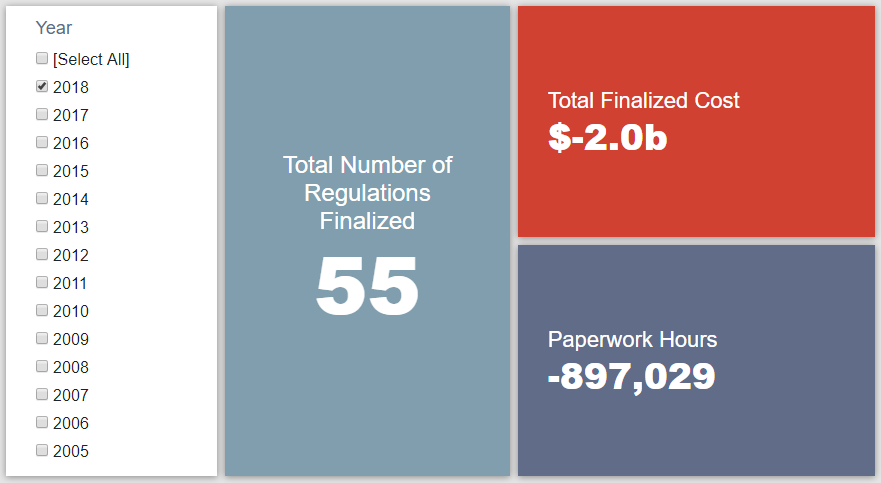Week in Regulation
March 19, 2018
Significant Deregulatory Push
Last week saw a notable deregulatory trend. Of the six rules with monetized cost estimates, only two added new costs totaling roughly $2 million. The other four rules’ savings dwarfed that total. Between both proposed and final rules, agencies published roughly $2.6 billion in net cost savings and 3,850 hours of additional paperwork. The per capita regulatory burden for 2018 is negative $5.98.
Regulatory Toplines
- New Proposed Rules: 38
- New Final Rules: 75
- 2018 Total Pages of Regulation: 11,646
- 2018 Final Rules: -$2 Billion
- 2018 Proposed Rules: -$3.3 Billion
Tracking Regulatory Modernization
The most significant regulatory reform measure from last week was a proposed rule from the Environmental Protection Agency (EPA). The proposal details the first phase of changes EPA seeks to make on “Coal Combustion Residuals” (CCR) regulations that the D.C. Circuit Court of Appeals remanded back to EPA in 2016. With more than $2 billion in potential savings, this action could be third largest cost reduction rulemaking, behind only EPA’s Clean Power Plan rescission and the Department of Labor’s “Fiduciary Rule” delay.
In terms of final rules, the most notable action applicable to the “regulatory budget” established under Executive Order (EO) 13,771 was a Department of Agriculture (USDA) rulemaking on organic certification. This rule rescinds one of the very last rules promulgated by the Obama Administration (published on January 19, 2017). USDA estimates that withdrawing that rule could save affected entities almost $500 million in total, undiscounted costs, or roughly $35 million annually.
According to AAF analysis, since the start of FY 2018 (beginning Oct. 1, 2017), executive agencies have promulgated 26 deregulatory actions with quantified cost savings against five regulatory measures that impose costs, under the rubric created by EO 13,771 and the administration’s subsequent guidance document on the matter. These rules combine for a net annual savings of roughly $719.3 million. This means that agencies have thus far surpassed the administration’s cumulative goal for FY 2018 of $687 million in net annual savings.
Click here to view AAF’s examination of the administration’s progress under the “one-in, two-out” executive order through the end of Fiscal Year 2017.
State of Major Obama-Era Initiatives
Based on total lifetime costs of the regulations, the Affordable Care Act has imposed costs of $53 billion in final state and private-sector burdens and 176.9 million annual paperwork hours.
Since passage, the Dodd-Frank financial reform legislation has produced more than 82.9 million final paperwork burden hours and imposed $38.9 billion in direct compliance costs.
Total Burdens
Since January 1, the federal government has published $5.3 billion in net costs savings ($2 billion from final rules) and new paperwork burdens amounting to 1.3 million hours (however, this includes 897,029 hours cut under final rules). Click here for the latest Reg Rodeo findings.











